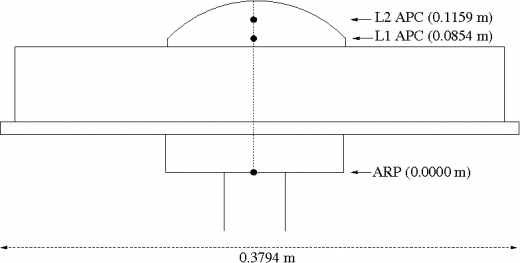If you wish to contribute or participate in the discussions about articles you are invited to contact the Editor
Antenna Phase Centre
| Fundamentals | |
|---|---|
| Title | Antenna Phase Centre |
| Author(s) | J. Sanz Subirana, J.M. Juan Zornoza and M. Hernández-Pajares, Technical University of Catalonia, Spain. |
| Level | Basic |
| Year of Publication | 2011 |
The GNSS measurements are referred to the so-called antenna phase centre. The position of the antenna phase centre is not necessarily the geometric centre of the antenna. Indeed, it is not constant, but it depends on the direction the radio signal coming in.
The phase centre is defined as the apparent source of radiation. If the source were ideal it would have a spheric equiphase contour, but the real case is slightly different, because the equiphase contour is irregular and each segment has its own apparent radiation origin.
Thus the phase centre of an antenna is not only angle dependant (elevation and azimuth) but also it depends on the signal frequency. A simple model is to assume that the phase centres are differs only on the vertical axis of the antenna, see figure 1. The manufacturers include technical sheets indicating the phase centre offsets.
To model the effect of the Antenna Phase Centre, it must be taken into account the contribution of the Receiver Antenna Phase Centre and the Satellite Antenna Phase Centre.
Antenna Phase Centre corrections for different models of receivers, relative to the AOA Dorne-Margolin T (AOAD/M_T) antenna [footnotes 1], were compiled by IGS and are provided in ftp://igscb.jpl.nasa.gov/igscb/station/general
These PCV files [footnotes 2], include NEU offsets of the mean phase centre location and Phase Centre Variations (PCVs) as a function of the elevation angle over [math]\displaystyle{ 10 }[/math] degrees. They were determined using short-baseline field measurements taking the AOAD/M_T antenna a as reference [Gendt, G. and Schmid, R., 2005] [1]. Nevertheless, as shown by [Mader, 1999][2], on long baselines, the relative PCVs are not adequate, even for the same antenna model.
On November 5th 2006, IGS switched from relative to absolute antenna phase centre corrections, which took place together with the adoption of ITRF2005 [1]. The absolute antenna phase centre offsets and PCVs are determined by a robotic system developed by the University of Hanover and the company Geo++ (see http://www.geopp.de}. They include azimuthal values and elevations down to [math]\displaystyle{ 0 }[/math] degrees.
IGS is compiling a consistent set of absolute antenna phase centre corrections for both receivers network and satellites, which are provided in so-called the Antenna Exchange Format (ANTEX) files [footnotes 3] in ftp://igscb.jpl.nasa.gov/igscb/station/general.
Since November 5th 2006 (GPS week 1400) the IGS products, i.e, SP3 files [footnotes 4] with the GPS and GLONASS precise orbits and clocks..., and the SINEX files with the computed precise coordinates of the reference stations network are associates to such ANTEX files with absolute antenna phase centre corrections (offsets and PCVs). It must be pointed out that users should not mix absolute and relative PCVs. Moreover absolute PCVs require corrections for both satellites and receiver antennas.
Notes
- ^ The IGS stations network was initially dominated by AOA Dorne-Margolin chocke ring antenna models.
- ^ See http://igscb.jpl.nasa.gov/igscb/station/general/igs\_01.txt.
- ^ See ANTEX format at: http://www.epncb.oma.be/ftp/station/general/antex13.txt.
- ^ A reference on the satellite antenna phase centres used is indicated in the header of SP3 files.
References
- ^ a b [Gendt, G. and Schmid, R., 2005] Gendt, G. and Schmid, R., 2005. IGSMAIL-5189: Planned changes to IGS antenna calibrations. http://igscb.jpl.nasa.gov/mail/igsmail/2005/msg00111.html.
- ^ [Mader, 1999] Mader, G., 1999. GPS antenna calibration at the National Geodetic Survey. GPS Solutions. 3(1), pp. 50-58.


